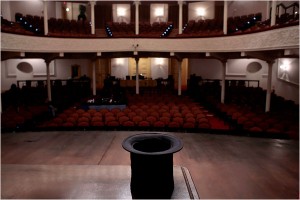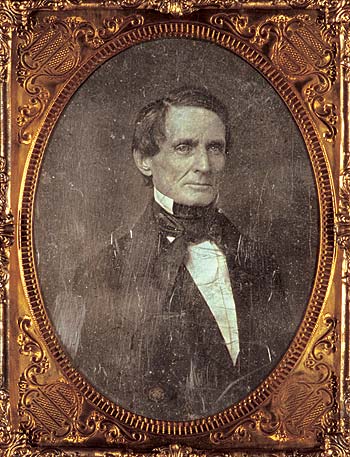 This year a freshman at Miami University in Ohio discovered a rare fingerprint from Abraham Lincoln just barely visible on one of his letters housed within the college’s archives. Lydia Smith, now a psychology major, made the discovery in November 2008 while examining a letter that Lincoln wrote on October 5, 1863. John Lupton, director of the Papers of Abraham Lincoln Project in Springfield, has verified the finding. Though there is some debate over how many known Lincoln fingerprints exist (see this post from Sam Wheeler), Lupton claims this is actually the second one in the Miami University collection and one of several that probably exist –most because of smudge marks in nineteenth-century ink but some, such as this one, imprinted on the rag paper. Read various news stories about this discovery or see a terrific YouTube video that details the whole episode.
This year a freshman at Miami University in Ohio discovered a rare fingerprint from Abraham Lincoln just barely visible on one of his letters housed within the college’s archives. Lydia Smith, now a psychology major, made the discovery in November 2008 while examining a letter that Lincoln wrote on October 5, 1863. John Lupton, director of the Papers of Abraham Lincoln Project in Springfield, has verified the finding. Though there is some debate over how many known Lincoln fingerprints exist (see this post from Sam Wheeler), Lupton claims this is actually the second one in the Miami University collection and one of several that probably exist –most because of smudge marks in nineteenth-century ink but some, such as this one, imprinted on the rag paper. Read various news stories about this discovery or see a terrific YouTube video that details the whole episode.
19
Aug
09
College Student Finds Lincoln Fingerprint
Posted by Matthew Pinsker Published in Civil War (1861-1865), Recent News, Recent Scholarship, Video Themes: Education & Culture14
Aug
09
California Digital Newspapers
Posted by sailerd Published in 19th Century (1840-1880), Images, Lesson Plans Themes: Settlers & Immigrants Digital collections of Civil War era newspapers are great resources and are available at a number of different sites. One that I want to highlight is UC Riverside’s California Digital Newspaper Collection, which includes the Daily Alta Californian (1849-1891) and the Sacramento Daily Union (1856-76). Each issue can be downloaded as a PDF file. Several lesson plans are also available on the site.
Digital collections of Civil War era newspapers are great resources and are available at a number of different sites. One that I want to highlight is UC Riverside’s California Digital Newspaper Collection, which includes the Daily Alta Californian (1849-1891) and the Sacramento Daily Union (1856-76). Each issue can be downloaded as a PDF file. Several lesson plans are also available on the site.
Teachers may also want to check out the USC Digital Library. This site offers several newspapers, including the Los Angeles El Clamor Publico (1855-1859) and the Los Angeles Star (1851-1864). Thousands of historic maps and images, such as California’s first State House, can also be downloaded.
10
Aug
09
PBS Videos Online
Posted by sailerd Published in 19th Century (1840-1880), Lesson Plans, Video Themes: Battles & Soldiers![]() PBS now offers on their website selected full-length episodes from programs like the American Experience. While these documentaries cover a wide variety of subjects, several episodes are on 19th century American history – Abraham Lincoln’s assassination, Walt Whitman, and Kit Carson. “We Shall Remain,” a documentary on Native American history, is also available.
PBS now offers on their website selected full-length episodes from programs like the American Experience. While these documentaries cover a wide variety of subjects, several episodes are on 19th century American history – Abraham Lincoln’s assassination, Walt Whitman, and Kit Carson. “We Shall Remain,” a documentary on Native American history, is also available.
Also be sure to check out NOVA and FRONTLINE. While neither show has video on 19th century American history, they still offer a number of interesting programs, such as “Astropies.”
5
Aug
09
“The Martyred President”
Posted by sailerd Published in Civil War (1861-1865), Rare Books Themes: Religion & Philosophy American history teachers may want to check out Emory University’s “The Martyred President,” which provides full text access to fifty seven sermons on Abraham Lincoln’s death. The site includes sermons from different regions and religious denominations, such as Rev. Richard Eddy’s “The Martyr to Liberty” (Universalist) and Rev. Samuel T. Spear’s “The Punishment of Treason” (Presbyterian). These sermons, however, are largely from northern ministers.
American history teachers may want to check out Emory University’s “The Martyred President,” which provides full text access to fifty seven sermons on Abraham Lincoln’s death. The site includes sermons from different regions and religious denominations, such as Rev. Richard Eddy’s “The Martyr to Liberty” (Universalist) and Rev. Samuel T. Spear’s “The Punishment of Treason” (Presbyterian). These sermons, however, are largely from northern ministers.
4
Aug
09
A Separate Country
Posted by osborne Published in Reconstruction (1865-1880) Themes: Education & Culture Admirers of Robert Hicks, the acclaimed author of Widow of the South will be very pleased to know that in a couple of weeks his new novel, A Separate Country, will appear. The new novel has as its main actor John Bell Hood and there are other connections, too, with Franklin, Tennessee. But the real hero of this remarkable new work is the city of New Orleans where Hood and others head to rebuild their lives and their fortunes. The Crescent City appears in all its racial, social, and economic complexity at a time following the Civil War when its “Americanization” was transforming its character. Separate Country will be published by Grand Central Publishing and is due out September 23.
Admirers of Robert Hicks, the acclaimed author of Widow of the South will be very pleased to know that in a couple of weeks his new novel, A Separate Country, will appear. The new novel has as its main actor John Bell Hood and there are other connections, too, with Franklin, Tennessee. But the real hero of this remarkable new work is the city of New Orleans where Hood and others head to rebuild their lives and their fortunes. The Crescent City appears in all its racial, social, and economic complexity at a time following the Civil War when its “Americanization” was transforming its character. Separate Country will be published by Grand Central Publishing and is due out September 23.
21
Jul
09
Sacred Memories: The Civil War Monument Movement in Texas
Posted by Published in 19th Century (1840-1880), Places to Visit Themes: Battles & Soldiers Lori Forgay of the Denton Record-Chronicle informed readers last week of a book concerning Texas Civil War monuments. “In Sacred Memories: The Civil War Monument Movement in Texas,” author Kelly McMichael explains what Civil War monuments meant to the people who erected them in Texas. After travelling to all 68 of the major Texas Civil War monuments, McMichael examines their history and what the monuments symbolize. McMichael also examines the controversery that is involved with all monuments, for trying to tell one side of a multi-faceted story. McMichael’s book is available through amazon.com.
Lori Forgay of the Denton Record-Chronicle informed readers last week of a book concerning Texas Civil War monuments. “In Sacred Memories: The Civil War Monument Movement in Texas,” author Kelly McMichael explains what Civil War monuments meant to the people who erected them in Texas. After travelling to all 68 of the major Texas Civil War monuments, McMichael examines their history and what the monuments symbolize. McMichael also examines the controversery that is involved with all monuments, for trying to tell one side of a multi-faceted story. McMichael’s book is available through amazon.com.
20
Jul
09
Ford's Theatre Now Open as a Theatre and Museum
Posted by parkd Published in Civil War (1861-1865), Images, Places to Visit Themes: Crimes & Disasters The infamous location of Lincoln’s assassination, Ford’s Theatre, reopened its doors in February with a dual functionality: theatre and museum. The Ford’s Theatre Society along with its partner the National Park Service renovated the historic Washington DC landmark, adding a 7,000 square foot exhibit which memorializes Abraham Lincoln, and restoring the theater to its appearance on the evening of April 14, 1865–the night John Wilkes Booth killed Lincoln. The memorial exhibit offers patrons an opportunity to familiarize themselves with the presidential tenure of Abraham Lincoln through mini exhibits that document his endeavors beginning with his inaugural train ride and ending with his funeral precession. Additionally, the balcony where Lincoln sat has been completely restored and will remain as a permanent exhibit within the actual theater.
The infamous location of Lincoln’s assassination, Ford’s Theatre, reopened its doors in February with a dual functionality: theatre and museum. The Ford’s Theatre Society along with its partner the National Park Service renovated the historic Washington DC landmark, adding a 7,000 square foot exhibit which memorializes Abraham Lincoln, and restoring the theater to its appearance on the evening of April 14, 1865–the night John Wilkes Booth killed Lincoln. The memorial exhibit offers patrons an opportunity to familiarize themselves with the presidential tenure of Abraham Lincoln through mini exhibits that document his endeavors beginning with his inaugural train ride and ending with his funeral precession. Additionally, the balcony where Lincoln sat has been completely restored and will remain as a permanent exhibit within the actual theater.
If you find yourself planning a tour of our nation’s capital, you should definitely add the Ford’s Theatre to your list of sites to see. However, if you don’t see yourself making the trip, I suggest you check out the society’s virtual tour. For more information you should look over the New York Times’ review of the theater as well as the accompanying slideshow of digital photographs.
17
Jul
09
Unknown Soldier Gets New Burial
Posted by Published in Civil War (1861-1865), Recent News Themes: Battles & SoldiersThe Nashville Business Journal informed readers yesterday morning of the newly set plan to re-inter an unknown Civil War soldier found at a construction site near Franklin, Tennessee. Those who have studied the soldier are unclear about which side he fought for, because of an amalgamation of uniforms. Though, it seems fairly clear that the soldier was probably killed at the Battle of Franklin, in late November of 1864. Yet, nonetheless, they know that he needs a proper burial. “We have to go through some legal procedures … before we can re-bury him,” explains the man in charge of the re-burial, Sam Grant. Because of such obstacles, the soldier will not be able to reach his final resting place until October, at the Rest Haven Cemetery. Such work by men like Sam Grant, continues the fight to preserve and honor our past.
14
Jul
09
Harpers Ferry Artillery Display
Posted by Published in Civil War (1861-1865), Places to Visit, Recent News Themes: Battles & Soldiers This weekend, the 18th and 19th of July, the National Park Service will hold an artillery demonstration at Harpers Ferry National Historical Park, the Charleston Daily Mail informed readers this morning. The display is to show viewers how Stonewall Jackson’s men took the Union arsenal in the Battle of Harpers Ferry, in 1862. Also, there will be a demonstration concerning Thomas “Stonewall” Jackson, informing the guests about the battle. These are just a few of these programs offered at Harpers Ferry National Historic Park, a great place to visit.
This weekend, the 18th and 19th of July, the National Park Service will hold an artillery demonstration at Harpers Ferry National Historical Park, the Charleston Daily Mail informed readers this morning. The display is to show viewers how Stonewall Jackson’s men took the Union arsenal in the Battle of Harpers Ferry, in 1862. Also, there will be a demonstration concerning Thomas “Stonewall” Jackson, informing the guests about the battle. These are just a few of these programs offered at Harpers Ferry National Historic Park, a great place to visit.
7
Jul
09
Civil War @ Smithsonian Goes Online
Posted by parkd Published in Civil War (1861-1865), Images Themes: Battles & Soldiers, Slavery & AbolitionThe Smithsonian recently brought their Civil War collection to the internet. The site allows users to view the different exhibits from the comfort of their own homes. Each exhibit displays an image as well as a relevant description of the artifact. The exhibits deal with issues such as slavery and abolition, soldiering, and leaders. Additionally, the Smithsonian created a timeline section that follows the course of historical events beginning with John Brown’s raid in 1859 and ending with the convictions of the Lincoln assassination conspirators in 1865. Also, the site lists a set of resources for each exhibit which includes general reference material, websites, and printed materials. As expected (from the Smithsonian) this website smashes a home run when it comes to making history engaging and accessible.
allows users to view the different exhibits from the comfort of their own homes. Each exhibit displays an image as well as a relevant description of the artifact. The exhibits deal with issues such as slavery and abolition, soldiering, and leaders. Additionally, the Smithsonian created a timeline section that follows the course of historical events beginning with John Brown’s raid in 1859 and ending with the convictions of the Lincoln assassination conspirators in 1865. Also, the site lists a set of resources for each exhibit which includes general reference material, websites, and printed materials. As expected (from the Smithsonian) this website smashes a home run when it comes to making history engaging and accessible.







